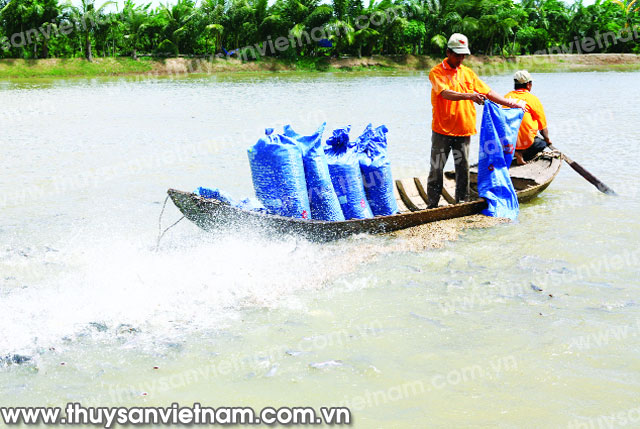Because Tra, Basa fish can tolerate low level of dissolved oxygen, they are normally raised at high density with much waste. If the waste management is not good, water in the raising ponds is easily polluted and diseases will break out.
Improve ponds and release fish
Pond area is of 500 m2 or more, depth is from 1.5 to 3.0 metres, the pond should be rectangular, square or round to enable the gathering of waste into the center of the pond, and reduce pollution in the raising ponds.
Before new raising periods, newly-dug ponds need line powder spreading on their beds and banks at a dose of 10 – 15 kg/100 m2, then must be the pond bed carefully raked to stabilize soil pH. Black mud in old ponds must be pumped to the garden or sludge pond, not to rivers or canals because it way pollute water. Waste separation in the pond by must be done by creating a rectangular, square, roundor conical hole with a small bottom, 1.5 m in depth, in the middle of pond, occupying 5 – 8% of pond area. Water sources to the pond need to be clean, muddy water (with much silt) should be avoid. When stocking fish, the density must be regulated (50 – 60 fish/m2), not higher.
Management and care
If farmers want to produce homemade feed to reduce raising costs, they need to calculate appropriate nutrient composition of feed quality and nutritional needs of each development stage of the fish. They also need to improve digestion by the fish, lower FCR and reduce the amount of fish discharge into the environment and limit water pollution. When processing feed, they should blend it with wool powder and glue powder to increase adhesion and reduce feed dissolving in water.
If they use industrial feed, choose reputable companies. Feed should be little soluble in water, of a suitable size so that when being fed, the fish can eat it out, avoiding redundancy.

If the waste management is not good, water in the raising ponds is easily polluted danh diseaser will break out – Photo: Gia Bao
Fish activities and weather change must be monitored on a daily basis to adjust the amount of feed. Additional enzyme to feed is needed to better digestion, reduce FCR and limit discharge into the environment.
According to experience of fish farmers in Vinh Long province and Can Tho city, daily constant feeding does not bring high efficiency due to the slow digestion and not thorough feed use; it reduces the nutrition absorbility in fish intestine. To stimulate the appetite of fish, limit the amount of sludge in the pond; this will help to save cost while ensuring the growth rate of the fish, the interrupting feeding method (3 days feeding, 1 day off) should be applied. When feeding, need to ensure right places, quality and time period to concentrate fish, reduce unuse fee, and avoid fish from becoming stunted.
After 1.5 month’s raising, farmers need to siphon fish elimination, algae remains depositing in the pond bed. Waste during anaerobic digestion producing toxic gases (H2S, NH3, NO2… ) directly poisons fish, while at the same time the organic humus decomposition produces nitrogen and phosphorus, creating good conditions for algae outbreaks, causing pollution and lack of oxygen in the water. Waste accumulation will be a heaven for harmful bacteria and parasites; in favorable conditions, they will grow quickly, causing diseases to fish. So at this time, farmers need to use probiotics to treat pond bed periodically in 10 – 15 days/time to produce biomass of useful bacteria overwhelming harmful bacteria, balance the biota in the pond.
Ventilation and sludge removal
For the fish from two months old onwards, farmers need to ventilate the ponds to increase dissolved oxygen in the water, help better fish respiration and lower FCR. Ventilation also helps bacteria in the pond bed to work more effectively and reduce pollution. Ventilation should be based on the fish head float in the morning. When the fish head floats long before diving in the morning, enhance ventilation at the time of 5 – 10 am and 13 – 17 pm. When fish mass in the pond reaches 2.5 kg/m3: ventilation should be done from 17 pm the previous day to 5 am the next morning. When fish mass reaches 6 kg/m3, ventilation must be mad continuously for 24 hours daily.
The installation and maintenance of airflow fans in the pond both increase dissolved oxygen in the water and gather residues into the reservoir in the pond centre; then farmers shoud use vacuum pumpe to suck the sludge out of the pond. Waste in ponds must be sucked out once a month; this method is pretty time-consuming but very effective because most of the scum in the pond bed is taken out, pond water will always be clean, fish will grow better. Farmers can transplant some algae eater (such as silver carp, tilapia…) into the pond to reduce algae growth.
|
>> According to the Economic and Planning Institute of Fisheries, the annual waste by raising Tra fish and Basa fish in the Mekong Delta is about 2 million tons. This source of waste can contain up to 45 percent nitrogen and 22 percent of the other components. It has not been thoroughly treated but discharged into rivers and canals, causing water pollution. |